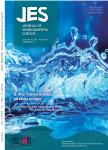Primary and secondary organic aerosol in an urban/industrial site: Sources, health implications and the role of plastic enriched waste burning
Primary and secondary organic aerosol in an urban/industrial site: Sources, health implications and the role of plastic enriched waste burning作者机构:National and Kapodistrian University of AthensLaboratory of Analytical ChemistryDepartment of ChemistryZografouGR-15784Greece
出 版 物:《Journal of Environmental Sciences》 (环境科学学报(英文版))
年 卷 期:2021年第33卷第1期
页 面:222-238页
核心收录:
学科分类:07[理学] 070602[理学-大气物理学与大气环境] 0706[理学-大气科学]
基 金:This research is co-financed by Greece and the European Union (European Social Fund- ESF) through the Operational Programme «Human Resources Development, Education and Lifelong Learning»in the context of the project “Strengthening Human Resources Research implemented by the State Scholarships Foundation (IK ϒ)
主 题:Primary organic aerosol(POA) Secondary organic aerosol(SOA) Plastic waste burning emissions GC/MS Source apportionment PCA
摘 要:PM_(1)0 samples were collected from an urban/industrial site nearby Athens,where uncontrolled burning activities ***,monocarboxylic,dicarboxylic,hydroxycarboxylic and aromatic acids,tracers from BVOC oxidation,biomass burning tracers and bisphenol A were ***,monocarboxylic acids,biomass burning tracers and bisphenol A were increased during autumn/winter,while BSOA tracers,dicarboxylic-and hydroxycarboxylic acids during *** aromatic acids,different sources and formation mechanisms were indicated as benzoic,phthalic and trimellitic acids were peaked during summer whereas p-toluic,isophthalic and terephthalic were more abundant during autumn/*** Benzo[a]pyrene-equivalent carcinogenic power,carcinogenic and mutagenic activities were calculated showing significant(p0.05)increases during the colder ***,succinic and malic acids were the most abundant monocarboxylic,dicarboxylic and hydrocarboxylic acids during the entire sampling *** oxidation was the most significant contributor to BSOA as the isoprene-SOA compounds were two times more abundant than the pinene-SOA(13.4±12.3 and 6.1±2.9 ng/m^3,respectively).Ozone has significant impact on the formation of many studied compounds showing significant correlations with:isoprene-SOA(r=0.77),hydrocarboxylic acids(r=0.69),pinene-SOA(r=0.63),dicarboxylic acids(r=0.58),and the sum of phthalic,benzoic and trimellitic acids(r=0.44).PCA demonstrated five factors that could explain sources including plastic enriched waste burning(30.8%),oxidation of unsaturated fatty acids(23.0%),vehicle missions and cooking(9.2%),biomass burning(7.7%)and oxidation of VOCs(5.8%).The results highlight the significant contribution of plastic waste uncontrolled burning to the overall air quality degradation.



